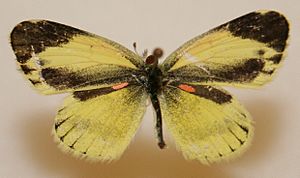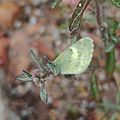Dainty sulphur facts for kids
Quick facts for kids Dainty sulphur |
|
|---|---|
 |
|
| Conservation status | |
| Scientific classification | |
| Kingdom: | |
| Phylum: | |
| Class: | |
| Order: | |
| Family: | |
| Genus: |
Nathalis
|
| Species: |
N. iole
|
| Binomial name | |
| Nathalis iole (Boisduval, 1836)
|
|
The Nathalis iole, also known as the dainty sulphur or dwarf yellow, is a small butterfly found in North America. It belongs to the Pieridae family, which includes many white and yellow butterflies. This butterfly is known for its delicate appearance and interesting life cycle.
Contents
What Does the Dainty Sulphur Look Like?
The dainty sulphur is the smallest butterfly in its family found in North America. Even though its look can change a lot, it's usually easy to tell apart from other butterflies.
Wing Colors and Patterns
- The top side of its wings is bright yellow.
- The tips of its front wings are black.
- Black bars run along the back edge of the front wing and the front edge of the back wing.
- Male dainty sulphurs have a special reddish-orange scent patch on their back wings. This patch helps them attract females. After the butterfly dies, this spot fades to a pale yellow.
Seasonal Changes
The underside of the dainty sulphur's wings changes with the seasons:
- Butterflies seen in summer have yellowish back wings.
- Butterflies seen in winter have greenish-gray back wings.
- Both types have black spots near the edge of the front wing and a yellowish-orange patch near the base of the front wing.
How to Tell it Apart from Similar Butterflies
There are a couple of other butterflies that look a bit like the dainty sulphur. These include the barred yellow and the little yellow.
Barred Yellow
The barred yellow (Eurema daira) is bigger than the dainty sulphur. The underside of its wings is either all grayish-white or brownish-red.
Little Yellow
The little yellow (Eurema lisa) is also larger than the dainty sulphur. It does not have the black bars on the top of its wings. Also, the underside of its front wing does not have the black spots or the yellowish-orange patch that the dainty sulphur has.
Where Does the Dainty Sulphur Live?
The dainty sulphur butterfly can live in many different open areas. You might find it in:
- Coastal flatlands
- Deserts
- Open fields
- Roadsides
- Empty lots and waste areas
It usually flies very close to the ground, often just a few inches high.
Life Cycle of the Dainty Sulphur
The dainty sulphur has an interesting life cycle, going through different stages from egg to adult butterfly.
Finding a Mate
Male dainty sulphurs fly low to the ground, looking for females. If a female isn't interested, the male might open his wings wide. This shows off his black bars and scent spots, often making the female change her mind!
Eggs and Larvae
- Females lay their eggs one by one on young leaves of certain plants. The eggs are either lemon-yellow or orange-yellow.
- The eggs hatch into larvae (caterpillars) in about 4 to 7 days.
- The larvae can look different. Some are dark green, while others are dark green with bright pinkish-purple stripes.
- These caterpillars have stiff hairs and two small pinkish-red bumps just above their head.
Chrysalis and Winter Survival
- The larva then turns into a chrysalis (pupa), which is green or yellow-green with yellow-white dots. Unlike most butterflies in its family, its chrysalis does not have a projection on its head.
- Dainty sulphurs cannot survive cold winters. They fly south to warmer places when the weather gets cold.
- If a caterpillar grows during short days, it will form a chrysalis that produces a butterfly with more dark scales. These darker scales help the butterfly absorb more heat from the sun, which is helpful in cooler weather.
- This butterfly has many generations (broods) each year.
What Do Dainty Sulphur Caterpillars Eat?
Dainty sulphur caterpillars eat leaves from specific plants, which are called "host plants." Here are some of their favorite host plants:
- Spanish needles (Bidens bipinnata)
- Beggar ticks (Bidens species)
- Dogweed (Dyssodia species)
- Common chickweed (Stellaria media)
- Greentread (Thelesperma species)
Images for kids




